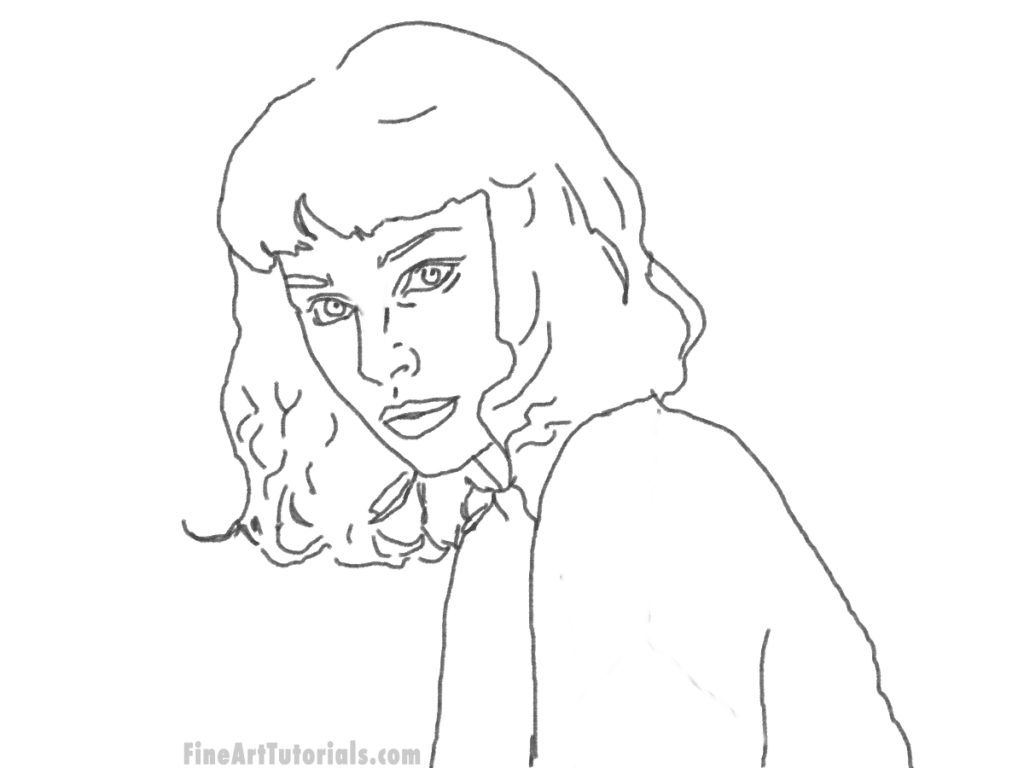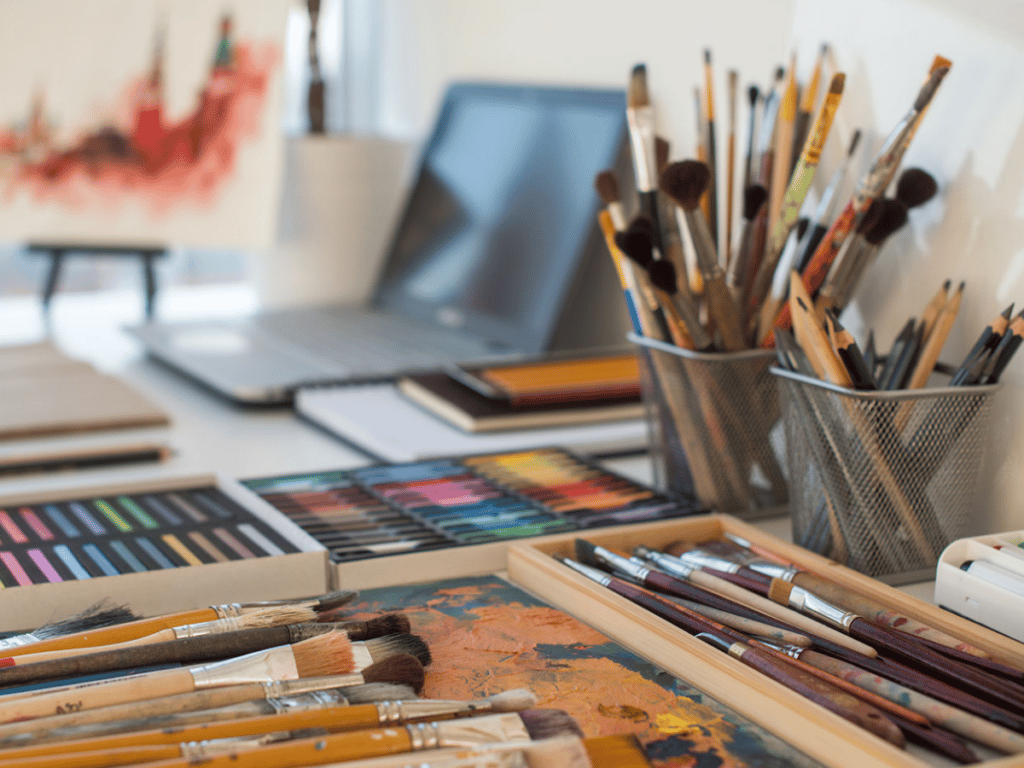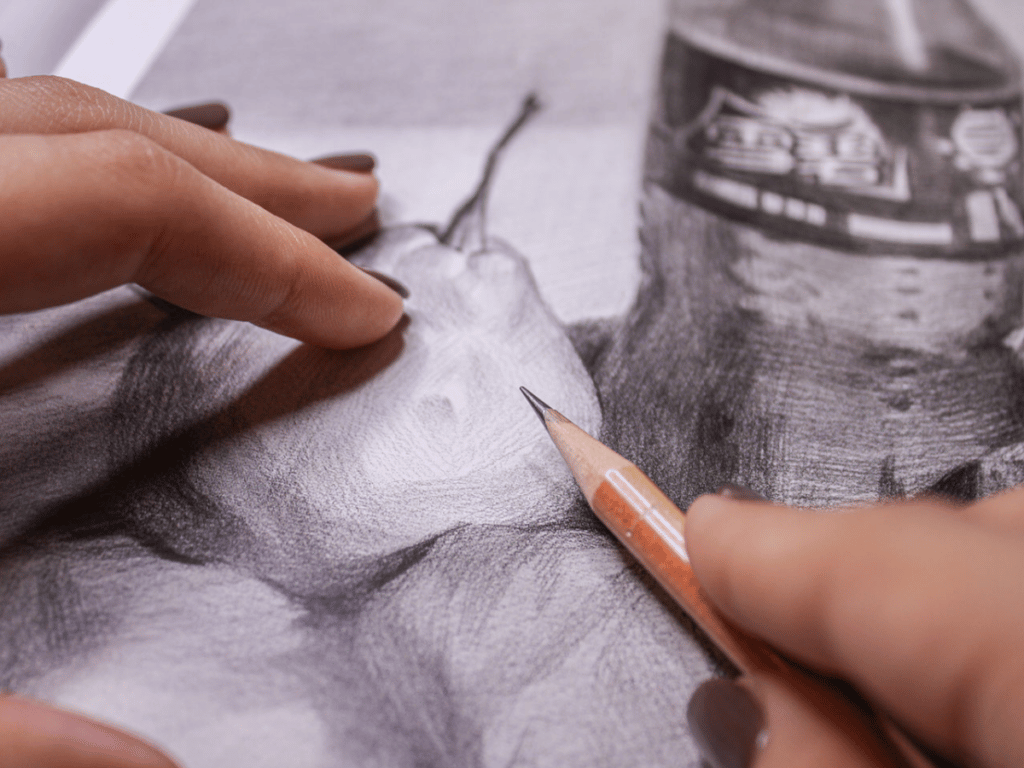Are you a beginner artist looking for tips and advice on how to sketch? Our guide will show you how to quickly get up and running, giving you tips on the drawing process, different supplies and techniques.
Disclaimer: Fine Art Tutorials is a reader supported site. When you make purchases through links on this site, we may earn a small commission at no extra cost to you.
Tips for How to Sketch

- Start drawing simple subjects: fill a page with basic shapes and try to replicate each one with precision. Focus on drawing the line lengths and angles accurately.
- Gradually move on to drawing more complex subjects: When you feel comfortable, challenge yourself by drawing more detailed subjects. More detailed subjects are just made up of a series of basic shapes, so it can help to break your reference down before starting your sketch.
- Study your reference: draw from photos or life. Try to really observe the subject before starting the drawing; this will help your drawings be more accurate and realistic.
- Invest in supplies: buy good quality paper and pencils. Different types of paper can affect how your sketch looks and soft pencils will help you achieve darker shadows.
Exercises to Improve Your Sketching
The best way to improve at sketching is by trying different drawing exercises and making them a part of your routine.
Sketching is a skill that requires practice, so make time to sketch regularly. Drawing exercises will help you to isolate and focus on specific skills that can be worked on to make your drawings more accurate
Contour drawing

Contour drawing is a great exercise for improving your accuracy and precision. This exercise eliminates the use of shading and relies on using lines to outline the form of your subject. Start with simple objects like cups or fruit, then move on to more complex subjects such as buildings or people. Contour drawing will help you become familiar with the shapes and forms of things, which will help you become more confident when sketching.
Speed drawing
To do this drawing exercise, start by setting a timer for around one minute and then try to complete the sketch within that time limit. Try to pay attention to all of the details, but don’t worry if it doesn’t turn out perfect—just focus on getting as much done in the time limit as you can. Speed drawing is a great exercise for improving your sketching speed and accuracy, which will be helpful in the long run.
Gesture drawing

Gesture drawing is a useful exercise for capturing movement and expression. It involves quickly sketching a subject while trying to capture their gestures in just a few strokes. This type of drawing can help you become more familiar with the movements of people or animals, which will come in handy when sketching complex scenes.
The Sketching Process
If you’re planning on tackling a larger drawing, that you aim to spend a bit longer on, this is a foolproof process that will help you to instantly use your existing skills to the best of your ability.
Plan your composition
The first step of creating a successful drawing is in mapping out where all the main elements will go. You essentially want to make sure that your subject and all the other elements of the drawing fit within the edges of the piece of paper. It sounds obvious, but if you miss this step, it’s really easy to get carried away and get the scale and proportions wrong.
The best way to plan a composition is to make a series of composition thumbnail sketches in a sketchbook. Spend about a minute on each and roughly outline how your scene will fit together. If you want to go a step further, read our composition blog post. It’s aimed at intermediate artists, but it will give you all the foundational knowledge you need to know about designing an aesthetically pleasing piece of art.
Mark where the main elements will go

Now that you’ve planned how your main subjects will fit together, or how your subjects will relate to the scene you are trying to draw with the thumbnail sketches, it’s time to start sketching it on the paper.
Mark the outer edges of the drawing. With light lines, you should mark the top, bottom and sides of the elements in your drawing, to make sure they don’t spill over the edges. This way, you know the bounds that you need to work inside of.
Measure the proportions

Look at the reference and measure the relative distance between different elements. There are ways to accurately measure proportions so that you can replicate the reference precisely. Sighting, by using your pencil as a measuring device and translating the placement of different features onto the paper. Another method is the grid method, whereby you divide the paper into small sections and measure which section on the reference would correspond to each one on your drawing.
You don’t have to use a measuring method, you can roughly determine the distances between features as well. For example, if you were drawing a face, you can estimate that the face would be around 1 1/2 the length, compared to the width. Use these points of measurement to put markers for where the features are placed on the paper.
Light outlines

When you’re ready to start sketching, begin by lightly outlining the shapes of your subject with a hard pencil (H). Take your time to get it right—don’t rush! As you move along, use a softer pencil (2B-9B) to darken and shade your lines as needed. If you’ve made any mistakes or want to erase something, use a kneaded eraser. This will allow you to create highlights or lighten areas of your sketch without smudging your work.
Build layers of shading

Once you’re happy with your outline, you can start to add depth. Start with the mid-tones, and gradually darken the shadows as you go. Leave the white of the paper to show through for the highlight tones. Lift highlight details with a kneaded eraser. When drawing this butterfly, I started with the darkest tones instead of the mid-tones, as they were separate from the orange sections of the wings.
Create texture

Instead of spending lots of time drawing all the tiniest details, focus on creating the illusion of texture. Use a variety of mark-making techniques, like hatching, cross-hatching, scribbling or scumbling. Layer these marks, varying the pressure you apply on the pencil. This can work well for areas where there are repeated patterns, or organic textures, like grasses, leaves or even hair texture.
Creating a successful sketch is all about creating variety and focus. So you could add in a few finer details to draw the viewer’s attention to those areas, then create more abstract textures for the other areas.
Finishing touches

Once you’ve finished your sketch, take a step back from it and look at it objectively. Add any finishing touches that are needed, like extra details, darkening some shadows or adding more layers to highlights. If you want to learn how to draw a butterfly like this, check out our tutorial!
Supplies to Get Started With Sketching

Part of learning how to sketch is learning how to use your materials. You’ll need a drawing surface, like paper or a sketchbook, as well as pencils and erasers.
It may be beneficial to pick up some different grades of pencils if you want to create darker shadow marks. Pencil grades range from hard (H) to soft (9B). Softer pencils will allow you to create darker lines and more contrast in your drawing, whereas harder pencils are great for outlining
It’s also helpful to have a kneaded eraser. This is an incredibly useful tool for artists, as it allows you to manipulate and shape the eraser into different forms, perfect for creating highlights or lightening areas of a sketch.
Find Your Reference & Get Set Up

A sketching reference could be anything from an image you found on a royalty free site or a photograph of your own. Choose something that inspires you and makes you want to draw!
Once you’ve picked out your reference, set up your workspace somewhere comfortable and well-lit. You may want to use a desk lamp or position yourself near a window for natural light. Make sure you have enough room to spread out your materials. However, you can sketch anywhere you feel comfortable! That might even mean taking your sketchbook out with you and working on the go. There are really no obstacles to stop you from starting a sketching practice if you want to start one!
A Sketchbook is for Experimenting and Practising
Don’t worry about making mistakes in your sketchbook. It’s a place for you to experiment and make mistakes without fear. After all, practice makes perfect!
When you’re done with your sketch, take a step back and evaluate what could be improved. Better yet, show it to a friend or family member for their opinion. By looking critically at your work, you can better improve on future sketches.
Sketching Techniques for Beginners

Learning new sketching techniques can help you improve your drawings and bring variety to your work. Here are some of the most popular sketching techniques:
- Hatching: Hatching involves drawing closely spaced parallel lines to create the illusion of shade or texture. This technique is useful for adding depth and detail to your sketches.
- Cross-Hatching: This is a variation of hatching, where you draw two layers of parallel lines at an angle to each other. Cross-hatching produces a richer, deeper shade or texture, allowing you to show variations in light and shadow.
- Stippling: Stippling uses tiny dots to create shade and texture, with closer dots making darker areas and fewer dots for lighter areas. While it can be time-consuming, the results can be striking and highly detailed.
- Tonal Shading: Tonal shading involves applying pressure to the pencil to suggest light and shade. It’s a fundamental technique that can give your sketches a realistic, three-dimensional appearance.
Easy Sketching Ideas

Here are some easy drawing ideas that beginners can use to get started:
- Draw things you see in your environment, such as furniture, objects or people.
- Copy a simple sketch from a book or online tutorial.
- Find an inspiring photograph and recreate it.
- Create a still life with everyday objects such as fruits or plants.
- Draw from memory, conjuring up images in your mind of places you’ve been to or people you know.
- Doodle abstract shapes and patterns on paper or canvas.
- Move on to drawing simple subjects. Check out our easy drawing ideas guide for tutorials.
Create a Drawing Practice
The best way to learn how to sketch is to set up a regular drawing practice. Try to draw regularly, whether that is just 10 minutes a day when you have some free time in the evening, or it could even be for a longer session each week. Whatever works for you and fits into your schedule. Start by trying to fill your sketchbook, practising different drawing exercises and trying different techniques. Then build it up to tackling subjects of your choice.
Learning how to sketch is a journey of exploration and creativity. It’s important to equip yourself with the right materials, find inspiration in the world around you, and constantly practice new techniques. Don’t be afraid of making mistakes; they are part of the learning process. Remember, the key to improving your sketching skills is consistent practice. So, grab your sketchbook, and let your artistic journey begin. Happy sketching!

